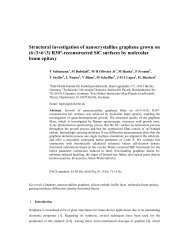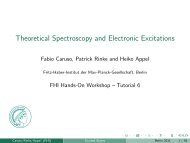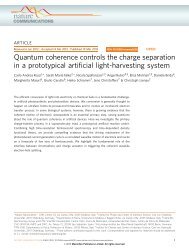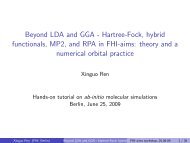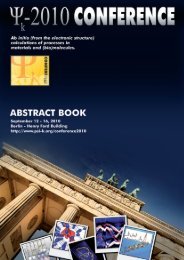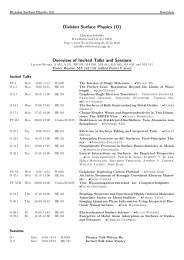A one-dimensional ice structure built from pentagons - Theory ...
A one-dimensional ice structure built from pentagons - Theory ...
A one-dimensional ice structure built from pentagons - Theory ...
You also want an ePaper? Increase the reach of your titles
YUMPU automatically turns print PDFs into web optimized ePapers that Google loves.
ARTICLES<br />
PUBLISHED ONLINE: 8 MARCH 2009 | DOI: 10.1038/NMAT2403<br />
A <strong>one</strong>-<strong>dimensional</strong> <strong>ice</strong> <strong>structure</strong> <strong>built</strong> <strong>from</strong> <strong>pentagons</strong><br />
Javier Carrasco 1,2 , Angelos Michaelides 1,2 *, Matthew Forster 3 , Sam Haq 3 , Rasmita Raval 3<br />
and Andrew Hodgson 3<br />
Heterogeneous <strong>ice</strong> nucleation has a key role in fields as diverse as atmospheric chemistry and biology. Ice nucleation on metal<br />
surfaces affords an opportunity to watch this process unfold at the molecular scale on a well-defined, planar interface. A<br />
common feature of structural models for such films is that they are <strong>built</strong> <strong>from</strong> hexagonal arrangements of molecules. Here<br />
we show, through a combination of scanning tunnelling microscopy, infrared spectroscopy and density-functional theory, that<br />
about 1-nm-wide <strong>ice</strong> chains that nucleate on Cu(110) are not <strong>built</strong> <strong>from</strong> hexagons, but instead are <strong>built</strong> <strong>from</strong> a face-sharing<br />
arrangement of water <strong>pentagons</strong>. The pentagon <strong>structure</strong> is favoured over others because it maximizes the water–metal<br />
bonding while maintaining a strong hydrogen-bonding network. It reveals an unanticipated structural adaptability of water–<strong>ice</strong><br />
films, demonstrating that the presence of the substrate can be sufficient to favour non-hexagonal structural units.<br />
In view of the familiarity and seeming simplicity of <strong>ice</strong> nucleation,<br />
our understanding of the molecular processes involved remains<br />
in its infancy, without any clear model for heterogeneous <strong>ice</strong><br />
nucleation on the nanoscale. So far the clearest insight into the<br />
molecular details of the initial stages of <strong>ice</strong> nucleation has come by<br />
means of experimental and theoretical surface science techniques,<br />
which enable determination of how individual water molecules<br />
arrange on well-defined solid substrates 1–12 . Through such studies a<br />
tremendous array of water–<strong>ice</strong> <strong>structure</strong>s, ranging <strong>from</strong> individual<br />
water hexamers to extended hexagonal <strong>one</strong>-<strong>dimensional</strong> (1D), 2D<br />
and 3D overlayers, have been reported. These studies have not<br />
been free <strong>from</strong> controversy, however, with numerous conflicts<br />
over the nature of the <strong>structure</strong>s formed, most notably in recent<br />
years over the existence or otherwise of the standard hexagonal<br />
‘bilayer’ model or whether some of the water molecules in the<br />
<strong>structure</strong>s dissociate 3,4,7–16 . Nevertheless, a common feature of<br />
structural models discussed at present is that they are <strong>built</strong> <strong>from</strong><br />
hexagonal arrangements of molecules.<br />
Here, we investigate the initial stages of <strong>ice</strong> nucleation on a<br />
Cu(110) substrate. Water is found to aggregate into about 1-nmwide<br />
chains, as previously reported 1,2 . However, we show, through a<br />
combination of scanning tunnelling microscopy (STM), reflection<br />
absorption infrared spectroscopy (RAIRS) and density-functional<br />
theory (DFT), that the <strong>ice</strong> chains are not <strong>built</strong> <strong>from</strong> hexagons,<br />
but instead are <strong>built</strong> <strong>from</strong> a face-sharing arrangement of water<br />
<strong>pentagons</strong>. Analysis of the atomic and electronic <strong>structure</strong>s of the<br />
various overlayers considered, reveals that the pentagon <strong>structure</strong><br />
is favoured over others (such as 1 and 2D hexagonal overlayers)<br />
because it maximizes the proportion of water molecules that<br />
interact strongly with the substrate while maintaining relatively<br />
strong hydrogen bonding with minimal strain within the overlayer.<br />
Calculations on other face-centred-cubic (f.c.c.) (110) surfaces<br />
suggest that the latt<strong>ice</strong> constant of the substrate has the decisive role<br />
in the balance between pentagon and hexagon motifs.<br />
Dosing water to sub-monolayer (ML) coverage resulted in the<br />
formation of ordered 1D chains, as previously reported 1,2 (Fig. 1).<br />
These chains are highly reproducible, forming across the entire<br />
temperature range explored (100–140 K), although they become<br />
labile at the lowest coverage (short chains) and at the higher<br />
temperatures. At low coverage (less than about 0.3 ML, estimated<br />
<strong>from</strong> both STM and RAIRS), water forms exclusively 1D chains at<br />
all temperatures examined. As the coverage is increased, the chains<br />
get closer to each other until this phase saturates with the chains<br />
still separated by at least 10 Å <strong>from</strong> each other. At higher coverage<br />
(greater than about 0.3 ML), regions of an extended 2D <strong>structure</strong><br />
form, which coexist with the 1D chains. There is no evidence that 2D<br />
island formation is kinetically inhibited, for example, by a reduction<br />
in the chain density as 2D islands form, or that the chain density is<br />
sensitive to the temperature or water adsorption rate. RAIRS shows<br />
that 1D chains are reformed on heating high-coverage <strong>structure</strong>s<br />
(such as the complete high-coverage 2D (7 × 8) <strong>structure</strong> 15 or<br />
multilayers) to desorb water and decrease the coverage, consistent<br />
with the observation of Yamada et al. of 1D chains being formed<br />
following desorption of water multilayers 1 . Although caution must<br />
in general be exercised in considering how kinetic aspects of <strong>ice</strong><br />
film preparation can change the relative proportion of different<br />
phases observed, the evidence described strongly suggests that<br />
1D chains are the thermodynamically stable phase for water on<br />
Cu(110) at low coverage.<br />
The 1D chains are characterized by bright ‘zigzagged’<br />
protrusions that run along the [001] direction, with a period of<br />
7.2 Å. High-resolution images of the Cu surface show that the<br />
protrusions sit above the troughs between the Cu rows (Fig. 1c),<br />
consistent with the previous study 1 . Some images (Fig. 1b) partially<br />
resolve the <strong>structure</strong> within the chains, showing a depression<br />
adjacent to the bright protrusions, which suggests the chains consist<br />
of hydrogen-bonded rings of water linked along the [001] direction.<br />
The lateral separation of the bright protrusions is 5.4 ± 0.4 Å.<br />
This is smaller than previously reported—a fact that we attribute<br />
to the better resolution obtained here—and inconsistent with<br />
the earlier suggestion that these protrusions represent an entire<br />
water hexamer 1 . We note that although water adsorbs and desorbs<br />
intact on clean Cu(110) (refs 15, 16), partial dissociation stabilizes<br />
adsorption, forming a c(2 × 2) <strong>structure</strong> 17 . By a careful series of<br />
studies of different partially dissociated OH/H 2 O <strong>structure</strong>s formed<br />
by O/water co-adsorption, we established that the chains under<br />
consideration here consist exclusively of intact water molecules (see<br />
Supplementary Information for more details).<br />
1 Fritz-Haber-Institut der Max-Planck-Gesellschaft, Faradayweg 4-6, D-14195 Berlin, Germany, 2 Materials Simulation Laboratory, London Centre for<br />
Nanotechnology and Department of Chemistry, University College London, London WC1E 6BT, UK, 3 Surface Science Research Centre, The University of<br />
Liverpool, Liverpool L69 3BX, UK. *e-mail: angelos.michaelides@ucl.ac.uk.<br />
NATURE MATERIALS | VOL 8 | MAY 2009 | www.nature.com/naturematerials 427
ARTICLES<br />
NATURE MATERIALS DOI: 10.1038/NMAT2403<br />
a<br />
b<br />
7.2 Å<br />
5.4 Å<br />
c<br />
[001]<br />
[110]<br />
[110]<br />
[001]<br />
Figure 1 | Experimental STM images of water on Cu(110). a, STM image taken at 100 K showing water chains growing along the [001] direction<br />
(120×140 Å, V = −196 mV, I = −0.63 nA). b, Expansion of a showing partial resolution of the water <strong>structure</strong> within the chain (38×35 Å). c, Image<br />
showing protrusions residing between the Cu rows in the [001] direction (50×30 Å, V = −196 mV, I = −0.34 nA).<br />
a b c d<br />
2.58<br />
3.62<br />
7.2<br />
7.2<br />
7.0<br />
5.9<br />
6.5 6.0<br />
7.2<br />
7.2<br />
Figure 2 | Models for 1D water chains on Cu(110). a–d, Equilibrium geometry and simulated STM images for a selection of <strong>structure</strong>s identified with DFT<br />
for water chains on Cu(110). Grey spheres correspond to Cu atoms, red <strong>one</strong>s to O atoms and small white <strong>one</strong>s to H atoms. The highest H atoms of each<br />
<strong>structure</strong>, which are responsible for the brightest features in the simulated STM images, are highlighted in yellow. In the simulated STM images, the<br />
locations of the water molecules in <strong>one</strong> surface unit are also shown. The most stable <strong>structure</strong> and the <strong>one</strong> we claim is observed in experiment is d, the<br />
pentagon-based <strong>structure</strong>. Distances are in Å.<br />
Extended <strong>ice</strong> <strong>structure</strong>s on metal surfaces are typically<br />
interpreted as being <strong>built</strong> <strong>from</strong> cyclic hexagons, related more or<br />
less to the hexagonal bilayer <strong>structure</strong> of the [0001] basal plane<br />
of <strong>ice</strong> I h (ref. 18). This includes the <strong>ice</strong> <strong>structure</strong>s that form on<br />
non-hexagonal metal surfaces, such as the (110) face of f.c.c. metals<br />
such as the Cu(110) substrate considered here 13–15 . On this basis,<br />
when applying DFT to calculate structural models of the chains, we<br />
first considered models based on hexagonal building blocks. All reported<br />
metal-supported <strong>ice</strong>-like models were considered, including<br />
the two hexamer-based <strong>structure</strong>s suggested for this specific system<br />
(for example, those depicted in Fig. 2a,b) 1,5,6,10,19 . From these calculations,<br />
several minimum-energy <strong>structure</strong>s were arrived at such as<br />
those shown in Fig. 2a–c, of which the adsorption energies, Eads TOT ,<br />
are reported in Table 1. However, on simulating the STM images<br />
of the corresponding <strong>structure</strong>s, it was clear that n<strong>one</strong> was entirely<br />
satisfactory. In particular, the hexameric <strong>structure</strong> offering the most<br />
compelling agreement with the experimental STM images (Fig. 2c)<br />
was not<strong>ice</strong>ably less stable (by 0.04 eV/H 2 O) than a <strong>structure</strong> that<br />
offered very poor agreement with experiment (Fig. 2b), as well as<br />
having a similar stability to other non-zigzag <strong>structure</strong>s.<br />
From the simulated STM images it was clear that the bright<br />
features responsible for the main contrast in the images are likely<br />
to be the OH groups of individual water molecules, which ‘dangle’<br />
away <strong>from</strong> the surface. We, therefore, considered <strong>structure</strong>s consisting<br />
of H-bonded networks of water molecules with alternating<br />
arrangements of dangling OH groups and the initial assumption<br />
428 NATURE MATERIALS | VOL 8 | MAY 2009 | www.nature.com/naturematerials
NATURE MATERIALS DOI: 10.1038/NMAT2403<br />
Table 1 | DFT adsorption energies, E TOT<br />
ads<br />
, of 1D chains on<br />
Cu(110), along with estimates of the water–water, E H 2O–H 2 O<br />
and water–metal, E H 2O–Cu<br />
ads<br />
, bonding in these <strong>structure</strong>s.<br />
Model<br />
E TOT<br />
ads<br />
E H 2O–H 2 O<br />
gas<br />
gas<br />
,<br />
E H 2O–Cu<br />
ads<br />
Fig. 2a 0.54 0.33 0.21<br />
Fig. 2b 0.56 0.29 0.27<br />
Fig. 2c 0.52 0.23 0.29<br />
Fig. 2d 0.59 0.29 0.30<br />
The <strong>structure</strong> with the largest adsorption energy is <strong>one</strong> based on <strong>pentagons</strong> (Fig. 2d). The units<br />
are eV/H 2 O.<br />
that the overlayer should be <strong>built</strong> exclusively <strong>from</strong> hexamers was<br />
dropped. This extended DFT-based structural search consisted of<br />
an extensive set of <strong>structure</strong>s <strong>built</strong> <strong>from</strong> arrangements of hexamers,<br />
pentamers and tetramers, and combinations thereof. The lowest<br />
energy <strong>structure</strong> identified in this search and, indeed, the lowest<br />
energy of any water chain <strong>structure</strong> is <strong>one</strong> consisting of a<br />
face-sharing arrangement of water <strong>pentagons</strong> (Fig. 2d). Note that<br />
this conclusion is unaltered when other DFT exchange–correlation<br />
functionals are considered or contributions such as zero-point<br />
energies or finite-temperature vibrational free-energy effects are<br />
accounted for (see Supplementary Information for more details).<br />
Furthermore, the simulated STM image of the pentagon <strong>structure</strong><br />
offers good agreement with experiment, reproducing the characteristic<br />
zigzag pattern with the correct periodicity along the [001] plane<br />
(7.2 Å between bright features), approximately correct width (6.0 Å)<br />
and with the bright features correctly located over the troughs<br />
of the (110) surface.<br />
ARTICLES<br />
RAIRS of the 1D chains offers further support for the claim<br />
that they are <strong>built</strong> <strong>from</strong> <strong>pentagons</strong> (Fig. 3a). The water chains<br />
have a distinct vibrational spectrum, quite different <strong>from</strong> that of<br />
the 2D <strong>ice</strong> monolayer that forms on this surface at saturation 15 .<br />
Specifically, RAIRS finds sharp, intense vibrational bands at 3,627,<br />
3,197, 1,573 and 753 cm −1 , along with broader less intense features<br />
near 3,440, 3,300 and 1,620 cm −1 (Fig. 3a). On calculation of<br />
the infrared spectrum of the pentagon and certain hexagon<br />
<strong>structure</strong>s, we find the best agreement is again offered by the<br />
pentagon <strong>structure</strong>. Indeed, in the computed infrared spectrum<br />
of the pentagon <strong>structure</strong> (Fig. 3d), all of the experimental<br />
vibrations are present at approximately the correct frequency<br />
with approximately correct relative intensities. In particular, the<br />
intense free O–H stretches are at 3,696 and 3,163 cm −1 compared<br />
to the experimental values of 3,627 and 3,197 cm −1 , whereas<br />
alternative <strong>structure</strong>s exhibit a much greater range of frequencies<br />
(Fig. 3b,c), as well as more (and higher frequency) librational<br />
bands than are observed (Fig. 3a). In addition, two molecular<br />
scissors bands are observed in experiment, a sharp low-frequency<br />
band at 1,573 cm −1 and the hydrogen-bonded scissors near<br />
1,620 cm −1 . Calculations for the pentamer chain reproduce the<br />
correct number of bands, with a hydrogen-bonded scissors band<br />
near 1,615 cm −1 and a sharp band at 1,545 cm −1 associated with<br />
the molecules located over the troughs in the pentagon <strong>structure</strong>,<br />
which are not involved in donating any hydrogen bonds. In<br />
contrast, calculations for the other <strong>structure</strong>s (Fig. 3b,c) show<br />
two sharp scissors bands at or below 1,600 cm −1 , in addition<br />
to the weak hydrogen-bonded water band, and are inconsistent<br />
with experiment. Inspection of the computed eigenmodes reveals<br />
that across the entire spectrum the intense stretching bands are<br />
associated with the non-donor water molecules located above<br />
the Cu(110) trenches.<br />
a<br />
3,627<br />
3,440<br />
3,300<br />
3,197<br />
1,620<br />
1,573<br />
753<br />
b<br />
3,705<br />
1,558<br />
c<br />
Intensity (arb. units)<br />
3,620<br />
3,739<br />
3,540<br />
3,420 1,601<br />
3,314<br />
3,249<br />
3,103<br />
3,536<br />
1,572<br />
3,358<br />
963<br />
863<br />
794<br />
1,525<br />
1,026 ¬ 1,046<br />
846<br />
3,269<br />
d<br />
3,696<br />
3,468<br />
1,615<br />
1,545<br />
3,373<br />
850 ¬ 825<br />
3,216<br />
3,163<br />
705<br />
4,000<br />
3,500<br />
3,000<br />
2,500<br />
2,000<br />
Wavenumber (cm –1 )<br />
1,500<br />
1,000<br />
Figure 3 | Experimental and computed infrared spectra for 1D water chains on Cu(110). a, Experimental RAIRS spectrum for water chains (about 0.3 θ sat )<br />
at 146 K. b,c, Computed infrared spectra for the hexagon-based <strong>structure</strong>s shown in Fig. 2b and c, respectively. d, Computed infrared spectrum for the<br />
pentagon-based 1D chains shown in Fig. 2d.<br />
NATURE MATERIALS | VOL 8 | MAY 2009 | www.nature.com/naturematerials 429
ARTICLES<br />
a<br />
b<br />
TOT<br />
E ads (eV/H 2 O)<br />
TOT TOT<br />
E ads, hexagon – E ads, pentagon (eV)<br />
0.60<br />
0.58<br />
0.56<br />
0.05<br />
0<br />
–0.05<br />
–0.10<br />
–0.15<br />
2 × 12<br />
2 × 9<br />
2 × 8<br />
2 × 6<br />
2 × 5<br />
2 × 4<br />
0 0.05 0.10 0.15 0.20 0.25<br />
1/d (Å –1 )<br />
Ni(110)<br />
Cu(110)<br />
d<br />
Pd(110)<br />
Ag(110)<br />
Total adsorption energy<br />
Gas phase water–water interaction<br />
3.5 3.6 3.7 3.8 3.9 4.0 4.1 4.2<br />
Ridge–ridge distance (Å)<br />
Figure 4 | Interaction between pentagon chains and relative energies of<br />
hexagon and pentagon chains on various metal surfaces. a, Adsorption<br />
energies of pentagon chains versus 1/d, where d is the shortest distance<br />
between atoms in adjacent chains. The labels for each point stand for the<br />
supercell used in the simulation. b, Adsorption energy difference between<br />
hexagon- (Fig. 2c type) and pentagon-based (Fig. 2d type) 1D chains as a<br />
function of the metal substrate. Negative values denote a preference for<br />
pentagonal chains. The differences in the gas-phase water–water<br />
interaction within each overlayer <strong>structure</strong> are also reported.<br />
Finally, the pentagon model is consistent with the observation<br />
<strong>from</strong> STM that chains maximize their separation <strong>from</strong> each<br />
other and transform into a 2D overlayer <strong>structure</strong> at high<br />
coverage. Specifically, DFT calculations of the interaction between<br />
chains—carried out by using unit cells with different widths—find<br />
a continuous drop in adsorption energy (destabilization) as the<br />
separation, d, between chains is reduced (Fig. 4a). This interaction<br />
follows a linear 1/d dependence, characteristic of electrostatic<br />
(charge–charge) repulsion, the chains repelling each other and<br />
becoming increasingly unstable as they are forced closer together<br />
with increasing coverage. The 1/d dependence suggests that the<br />
repulsion is dominated by through-vacuum repulsion and that the<br />
image charge in the metal does not have a significant influence on<br />
the form of the repulsion. At some point the stability of the 1D<br />
chains drops below that of the 2D overlayer, at which point the<br />
2D phase will nucleate. Experimentally this is seen to occur only<br />
once chains are forced within about 10–15 Å of each other during<br />
growth, causing water to abandon the commensurate adsorption<br />
site to form the complex 2D (7×8) <strong>structure</strong> 15 .<br />
We now consider why a 1D pentagon chain <strong>structure</strong> forms on<br />
this surface. Two factors are important. First there is the interaction<br />
with the substrate. This is strongest for flat-lying water molecules<br />
at atop sites of the Cu ridges. All low-energy <strong>structure</strong>s identified<br />
have a large proportion of water molecules at these sites, pinning the<br />
overlayer into registry with the substrate. The pentagon <strong>structure</strong> is<br />
NATURE MATERIALS DOI: 10.1038/NMAT2403<br />
particularly favourable with two thirds of the water molecules on Cu<br />
ridges and consequently the strongest water–metal interaction of<br />
the overlayers considered (Table 1). Second there is the water–water<br />
(hydrogen bonding) interaction. Here, we find that the optimal<br />
hydrogen-bonding arrangement is not necessarily the <strong>one</strong> with the<br />
largest proportion of hydrogen bonds per water molecule—as a<br />
traditional hexagonal 2D bilayer would have—but rather the <strong>one</strong><br />
that achieves the strongest hydrogen bonds with minimal strain<br />
within the overlayer. Indeed, fitting commensurate arrangements of<br />
hexagons across the [110] rows of the Cu substrate—as chains (for<br />
example, Fig. 2c) or the (unrepresentatively) high-symmetry 2D<br />
overlayer reported in refs 13, 14—requires about 1 Å compression<br />
of each hexagon compared with the ideal hexagonal geometry of<br />
<strong>ice</strong>. This introduces strain in the overlayers, which thus destabilizes<br />
these <strong>structure</strong>s; for example, the commensurate hexagon-based 1D<br />
chain (Fig. 2c) has an adsorption energy of 0.52 eV/H 2 O and the<br />
c(2 × 2) water <strong>structure</strong> reported in 13,14 an adsorption energy of<br />
0.54 eV/H 2 O, within the current computational set-up. In contrast,<br />
the staggered arrangement of smaller <strong>pentagons</strong>, with an adsorption<br />
energy of 0.59 eV/H 2 O, makes a better fit to the substrate. The idea<br />
that the strength of the hydrogen bonding within the overlayer is<br />
important to the relative stability of the <strong>structure</strong>s formed can be<br />
tested by calculations of the various 1D <strong>structure</strong>s in the gas phase<br />
(that is, without the substrate). These calculations find that, fixed<br />
in the <strong>structure</strong>s they assume on adsorption, a gas-phase 1D chain<br />
of <strong>pentagons</strong> is 0.06 eV/H 2 O more stable than a chain of hexagons.<br />
This matches almost exactly the 0.07 eV/H 2 O preference for<br />
<strong>pentagons</strong> over hexagons on the surface. Extensive tests with other<br />
DFT exchange–correlation functionals and with Møller–Plesset<br />
perturbation theory on the relative stability of the relevant pentamer<br />
and hexamer motifs in the gas phase demonstrate that the<br />
conclusion on relative stabilities arrived at here is not sensitive<br />
to our particular cho<strong>ice</strong> of exchange–correlation functional (see<br />
Supplementary Information for more details). Formation of the<br />
2D <strong>structure</strong> at higher coverage presumably alleviates strain by<br />
abandoning the simple commensurate adsorption site and adopting<br />
a (7 × 8) periodicity. Exploring the details of this phase transition<br />
with DFT requires characterization of the complex 2D (7 × 8)<br />
<strong>structure</strong>, about which little is known 15 .<br />
Let us now place the present results in a broader context and<br />
consider how <strong>ice</strong> might nucleate on other f.c.c. (110) surfaces. To<br />
this end, DFT was used to determine the <strong>structure</strong> and relative<br />
stability of 1D chains of hexagons and <strong>pentagons</strong> on the (110)<br />
surfaces of Ni, Pd and Ag. Along with Cu, this consists of a set of<br />
four (110) substrates with a separation between the close-packed<br />
[110] ridges that ranges <strong>from</strong> about 3.5 Å to about 4.2 Å. As<br />
shown in Fig. 4b, an interesting correlation between the relative<br />
stability of hexagon versus pentagon chains is observed. Pentagons<br />
are favoured on substrates with small latt<strong>ice</strong> constants; that is, in<br />
addition to Cu, Ni is identified as a substrate on which <strong>pentagons</strong><br />
may nucleate. Pd is a borderline case, whereas on the substrate<br />
with the largest latt<strong>ice</strong> constant Ag, there is a small preference for<br />
hexagons. The trend in the relative stability of hexamers versus<br />
pentamers as a function of latt<strong>ice</strong> parameter also holds for these<br />
<strong>structure</strong>s in the gas phase (open circles in Fig. 4b), providing extra<br />
support that hydrogen bonding within the water layers is key to the<br />
relative stability of hexamer versus pentamer chains.<br />
In summary, a combination of experimental scanning probe<br />
techniques, infrared vibrational spectroscopy and DFT leads to the<br />
characterization of an <strong>ice</strong>-like <strong>structure</strong> <strong>built</strong> <strong>from</strong> pentagon units.<br />
Although there is a precedent for pentagon-based <strong>ice</strong> <strong>structure</strong>s<br />
in other environments 20,21 , this is the first time that such a<br />
structural unit has been seen at a surface. The nucleation of<br />
<strong>pentagons</strong> reveals an unanticipated adaptability of water–<strong>ice</strong> films<br />
to optimize bonding within the overlayer and to the surface.<br />
In general, the detailed arrangement of water at interfaces is<br />
430 NATURE MATERIALS | VOL 8 | MAY 2009 | www.nature.com/naturematerials
NATURE MATERIALS DOI: 10.1038/NMAT2403<br />
not known <strong>from</strong> experiment and future studies should focus<br />
on identifying <strong>structure</strong>s that optimize the balance between<br />
water–metal and water–water bonding, rather than concentrating<br />
overly on hexagonal packing arrangements.<br />
Methods<br />
Experimental. Images of water adsorbed on Cu(110) were recorded at 100 K<br />
in an ultrahigh vacuum STM (Specs 150) operated in constant-current mode<br />
with an electrochemically etched tungsten tip. The Cu surface was prepared by<br />
argon ion sputtering at 500 eV followed by annealing to 800 K and showed an<br />
average terrace size of about 800 Å. Ultrapure (10 7 cm) water was dosed <strong>from</strong><br />
background gas at a pressure of 2 × 10 −9 mbar. To ensure the chain <strong>structure</strong><br />
observed is not caused by tip-induced re-structuring, images were taken using a<br />
variety of scanning angles and tunnelling conditions; all images yielded an identical<br />
<strong>structure</strong> oriented along [001], thus showing the negligible effect of the tip on<br />
the corresponding water <strong>structure</strong>. Reflection absorption infrared spectra were<br />
recorded at 80 K by a Mattson 6020 Fourier-transform infrared spectrometer,<br />
operated at the glancing angle with 4 cm −1 resolution using a broadband mercury<br />
cadmium telluride detector (650–4,000 cm −1 ) to record the OH stretching and<br />
libration regions simultaneously. The water coverage is estimated by calibrating the<br />
water dose against that required to form a complete monolayer (θ sat ) as determined<br />
by temperature-programmed desorption.<br />
Theoretical. The calculations involve DFT and supercell periodic models<br />
as implemented in the Vienna Ab-initio Simulation Package code 22,23 . The<br />
Perdew–Burke–Ernzerhof 24 exchange–correlation functional has been used and<br />
the inner electrons replaced by projector augmented wave pseudopotentials 25 ,<br />
expanded in a basis set of plane waves up to a cutoff energy of 415 eV. A<br />
Monkhorst–Pack grid with at least 12 × 12 × 1 k-point sampling per 1 × 1<br />
cell was used. Water/Cu(110) <strong>structure</strong>s were modelled in p(2 × n) unit cells,<br />
with n <strong>from</strong> 3 to 12. In all cases reported, a four-layer Cu slab was used<br />
separated by a 14 Å vacuum. The two bottom layers have been fixed to their bulk<br />
Perdew–Burke–Ernzerhof-optimal positions (a Cu = 3.627 Å) during <strong>structure</strong><br />
optimization procedures, with all other atoms fully relaxed. All of the above cho<strong>ice</strong>s<br />
of computational set-up have been carefully checked through an extensive series of<br />
test calculations, some of which are reported in Supplementary Information. STM<br />
images were simulated with the Tersoff–Hamann approach 26 , with a voltage of<br />
−200 meV and at a height of 6 Å above the metal surface. Vibrational frequencies<br />
were determined with a standard finite displacement method; the infrared<br />
intensities were calculated by estimating numerically the z comp<strong>one</strong>nt of the dipole<br />
moment derivative with respect to displacements along the z Cartesian comp<strong>one</strong>nt<br />
(see Supplementary Information for details).<br />
Adsorption energies, Eads<br />
TOT , per water molecule are obtained by subtracting<br />
the energy of the adsorbed nH 2 O ad<strong>structure</strong> <strong>from</strong> the sum of the energies of the<br />
relaxed bare metal slab and n isolated gas phase H 2 O molecules. The estimate of the<br />
water–water bonding, E H2O–H2O<br />
gas<br />
, is simply the water–water bonding in the gas-phase<br />
water <strong>structure</strong> in the absence of the substrate, but with all atoms fixed in the precise<br />
geometries they adopt in the adsorption <strong>structure</strong> 27 . The estimate of the water–Cu<br />
bonding, E H2O–Cu<br />
ads , is simply taken as the difference between E TOT and E H2O–H2O<br />
Received 18 July 2008; accepted 9 February 2009;<br />
published online 8 March 2009<br />
ads<br />
gas<br />
.<br />
References<br />
1. Yamada, T., Tamamori, S. & Okuyama, H. Anisotropic water chain growth<br />
on Cu(110) observed with scanning tunneling microscopy. Phys. Rev. Lett. 96,<br />
036105 (2006).<br />
2. Lee, J., Sorescu, D. C., Jordan, K. D. & Yates, J. T. Jr. Hydroxyl chain formation<br />
on the Cu(110) surface: Watching water dissociation. J. Phys. Chem. C 112,<br />
17672–17677 (2008).<br />
3. Feibelman, P. J. Partial dissociation of water on Ru(0001). Science 295,<br />
99–102 (2002).<br />
4. Menzel, D. Surface science—Water on a metal surface. Science 295,<br />
58–59 (2002).<br />
5. Michaelides, A. & Morgenstern, K. Ice nanoclusters at hydrophobic metal<br />
surfaces. Nature Mater. 6, 597–601 (2007).<br />
6. Cerda, J. et al. Novel water overlayer growth on Pd(111) characterized with<br />
scanning tunneling microscopy and density functional theory. Phys. Rev. Lett.<br />
93, 116101 (2004).<br />
ARTICLES<br />
7. Ogasawara, H. et al. Structure and bonding of water on Pt(111). Phys. Rev. Lett.<br />
89, 276102 (2002).<br />
8. Andersson, K., Nikitin, A., Pettersson, L. G. M., Nilsson, A. & Ogasawara, H.<br />
Water dissociation on Ru(001): An activated process. Phys. Rev. Lett. 93,<br />
196101 (2004).<br />
9. Weissenrieder, J., Mikkelsen, A., Andersen, J. N., Feibelman, P. J. & Held, G.<br />
Experimental evidence for a partially dissociated water bilayer on Ru(0001).<br />
Phys. Rev. Lett. 93, 196102 (2004).<br />
10. Haq, S., Clay, C., Darling, G. R., Zimbitas, G. & Hodgson, A. Growth of<br />
intact water <strong>ice</strong> on Ru(0001) between 140 and 160 K: Experiment and<br />
density-functional theory calculations. Phys. Rev. B 73, 115414 (2006).<br />
11. Meng, S., Wang, E. G. & Gao, S. W. Water adsorption on metal surfaces:<br />
A general picture <strong>from</strong> density functional theory studies. Phys. Rev. B 69,<br />
195404 (2004).<br />
12. Yang, Y., Meng, S. & Wang, E. G. Water adsorption on a NaCl (001) surface: A<br />
density functional theory study. Phys. Rev. B 74, 245409 (2006).<br />
13. Ren, J. & Meng, S. Atomic <strong>structure</strong> and bonding of water overlayer on Cu(110):<br />
The borderline for intact and dissociative adsorption. J. Am. Chem. Soc. 128,<br />
9282–9283 (2006).<br />
14. Ren, J. & Meng, S. First-principles study of water on copper and noble metal<br />
(110) surfaces. Phys. Rev. B 77, 054110 (2008).<br />
15. Schiros, T. et al. Structure of water adsorbed on the open Cu(110) surface:<br />
H-up, H-down, or both? Chem. Phys. Lett. 429, 415–419 (2006).<br />
16. Andersson, K. et al. Molecularly intact and dissociative adsorption of water on<br />
clean Cu(110): A comparison with the water/Ru(001) system. Surf. Sci. 585,<br />
L183–L189 (2005).<br />
17. Bange, K., Grider, D. E., Madey, T. E. & Sass, J. K. The surface-chemistry of<br />
H 2 O on clean and oxygen-covered Cu(110). Surf. Sci. 136, 38–64 (1984).<br />
18. Thiel, P. A. & Madey, T. E. The interaction of water with<br />
solid-surfaces—fundamental-aspects. Surf. Sci. Rep. 7, 211–385 (1987).<br />
19. Schiros, T. Water-Metal Surfaces. Doctoral Thesis in Chemical Physics<br />
(Stockholm Univ. 2008).<br />
20. Ma, B.-Q., Sun, H.-L. & Gao, S. Cyclic water pentamer in a tape-like <strong>structure</strong>.<br />
Chem. Commun. 2220–2221 (2004).<br />
21. Naskar, J. P., Drew, M. G. B., Hulme, A., Tocher, D. A. & Datta, D. Occurrence<br />
of ribbons of cyclic water pentamers in a metallo-organic framework formed<br />
by spontaneous fixation of CO 2 . Cryst. Eng. Comm. 7, 67–70 (2005).<br />
22. Kresse, G. & Hafner, J. Ab initio molecular-dynamics for liquid-metals.<br />
Phys. Rev. B 47, 558–561 (1993).<br />
23. Kresse, G. & Furthmüller, J. Efficient iterative schemes for ab initio<br />
total-energy calculations using a plane-wave basis set. Phys. Rev. B 54,<br />
11169–11186 (1996).<br />
24. Perdew, J. P., Burke, K. & Ernzerhof, M. Generalized gradient approximation<br />
made simple. Phys. Rev. Lett. 77, 3865–3868 (1996).<br />
25. Kresse, G. & Joubert, D. From ultrasoft pseudopotentials to the projector<br />
augmented-wave method. Phys. Rev. B 59, 1758–1775 (1999).<br />
26. Tersoff, J. & Hamann, D. R. <strong>Theory</strong> and application for the scanning tunneling<br />
microscope. Phys. Rev. Lett. 50, 1998–2001 (1983).<br />
27. Michaelides, A., Alavi, A. & King, D. A. Insight into H 2 O-<strong>ice</strong> adsorption and<br />
dissociation on metal surfaces <strong>from</strong> first-principles simulations. Phys. Rev. B<br />
69, 113404 (2004).<br />
Acknowledgements<br />
J.C. acknowledges financial support <strong>from</strong> the Alexander von Humboldt Foundation and<br />
the Royal Society. A.M.’s work is supported by a EURYI award (see www.esf.org/euryi)<br />
and by the EPSRC. A.H. acknowledges support by the EPSRC and R.R. by the EPSRC and<br />
BBSRC. Through our membership of the UK’s HPC Materials Chemistry Consortium,<br />
which is funded by the EPSRC (EP/F067496), this work made use of the facilities of<br />
HECToR, the UK’s national high-performance computing serv<strong>ice</strong>, which is provided<br />
by UoE HPCx Ltd at the University of Edinburgh, Cray Inc and NAG Ltd, and funded<br />
by the Off<strong>ice</strong> of Science and Technology through EPSRC’s High End Computing<br />
Programme. We are also grateful to the London Centre for Nanotechnology for<br />
computational resources and to Peter Feibelman for his helpful comments on an earlier<br />
version of this manuscript.<br />
Additional information<br />
Supplementary information accompanies this paper on www.nature.com/naturematerials.<br />
Reprints and permissions information is available online at http://npg.nature.com/<br />
reprintsandpermissions. Correspondence and requests for materials should be<br />
addressed to A.M.<br />
NATURE MATERIALS | VOL 8 | MAY 2009 | www.nature.com/naturematerials 431



